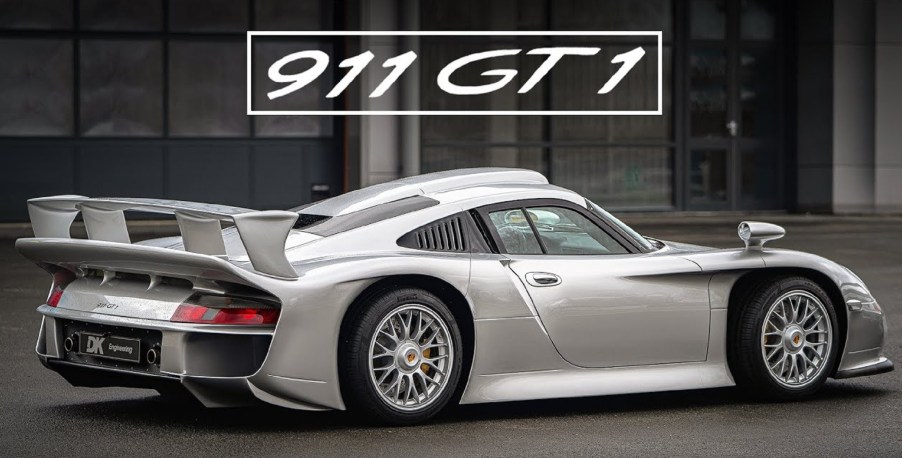
It’s Not a 911, but the Porsche 911 GT1 Is a True McLaren F1 Rival
Even today, the McLaren F1 and its racing-inspired analog design make it a legend in the supercar world. The Porsche Carrera GT is an icon for similar reasons. But while the Carrera GT wasn’t truly an F1 competitor, Porsche did make another car that was. And recently, YouTube team Carfection got a chance to drive that car: the Porsche 911 GT1.
The Porsche 911 GT1 is part 911, part 962, and all Le Mans-winning racer

‘GT’ is Porsche shorthand for models with a solid performance and/or motorsports focus. The original 911 GT3, for example, was a true homologation special with racing-derived tech. However, while the Porsche 911 GT1 is also a homologation special, it’s more extreme than any GT3.
In the ‘90s, Porsche wanted to race a car in the GT1 class at the 24 Hours of Le Mans. And to do so, it had to homologate that race car by selling a certain number of street-legal versions, Road & Track explains. That’s why the Porsche 911 GT1 street car (‘Straßenversion’ or ‘Strassenversion’) exists. But despite its name, it’s not a 911—or rather, it’s not fully a 911.

Here’s how this works. The front half of the Porsche 911 GT1—including the steel crash structure and carbon-fiber A-pillars—are from the 993-gen 911, R&T reports. However, the 911 GT1’s rear half comes from the 962 Group C Le Mans race car, R&T explains. That includes the 3.2-liter twin-turbocharged water-cooled flat-six engine that, unlike the engine in any other 911, is mid-mounted. Though admittedly, in 1997 Porsche gave the 911 GT1 some 996-gen 911 touches, most notably in the headlights and engine bay.
Compared to the race car, the road-going Porsche 911 GT1 is slightly detuned, with 537 hp instead of 592 hp, Automobile and DriveMag report. But that’s still good for a 0-60 mph time of 3.7 seconds. The later Evolution models are even faster, not to mention successful race cars in their own right, R&T notes. And the Porsche 911 GT1 was the last road car to win at Le Mans, its reliability letting it beat other contenders in the 1998 race, R&T reports.
Compared to the McLaren F1, the Porsche 911 GT1 is a much friendlier supercar

To be sure, the McLaren F1 is even faster than the Porsche 911 GT1. Car and Driver recorded a 0-60 mph time of 3.2 seconds in an F1, and it famously still holds the naturally-aspirated speed record of 240.1 mph. The 911 GT1 Strassversion, in comparison, tops out at ‘just’ 191 mph.
Plus, compared to the Porsche, the McLaren F1 is arguably the more exotic machine. The Toyota Sera-inspired butterfly doors; the gold-leaf-lined engine bay. It has a built-in Internet modem and the driver’s seat is in the middle. And even by modern standards, “the F1 feels legitimately quick for a supercar,” R&T reports.
However, as Carfection’s Henry Catchpole explains in the video above, driving a McLaren F1 demands your attention. The suspension, though comfortable, means the F1 rolls quite a bit for a supercar. And the relatively narrow tires add to both ride quality and roll. Add in responsive but unassisted steering and a narrow-gated but slick shifter, and it makes for an intense experience.
In contrast, the Porsche 911 GT1 is in some ways less and in some ways more of a true road car. On the one hand, it has an exposed interior roll cage and only two seats. And while it has a trunk, the F1 has two. It also lacks an audio system; the McLaren F1 at least has a CD changer. But the 911 GT1’s interior is straight out of a 993 911, with supportive leather seats and conventional doors.
And compared to the F1, the Porsche 911 GT1 is a significantly easier car to drive, Carfection reports. The steering is light and communicative, the shifter stiff and satisfying to use, and the supercar remains balanced through corners. And yet, in many ways, it still reminds Catchpole of a ‘normal’ 911. As a result, “you feel like you can push this much harder much more quickly” than the F1, he says. It might just be, Catchpole says, “the ultimate 911.”
Seeing on the road is a rare occasion
While the Porsche 911 GT1 might be easier to drive than the F1, it’s also noticeably rarer. McLaren made 107 F1s, almost all of which still exist. Reports differ on exactly how many 911 GT1s Porsche made, Autoweek notes, but the consensus is ‘around 25.’ And not all of those are in public hands, Autoblog notes.
As a result, seeing a 911 GT1 is a rarer event than seeing an F1. Getting a 911 GT1, though, is easier on the wallet. In 2017 one example sold at a Gooding & Co. auction for $5.66 million, The Drive reports. However, a McLaren F1 can easily go for three times that amount.
Follow more updates from MotorBiscuit on our Facebook page.


